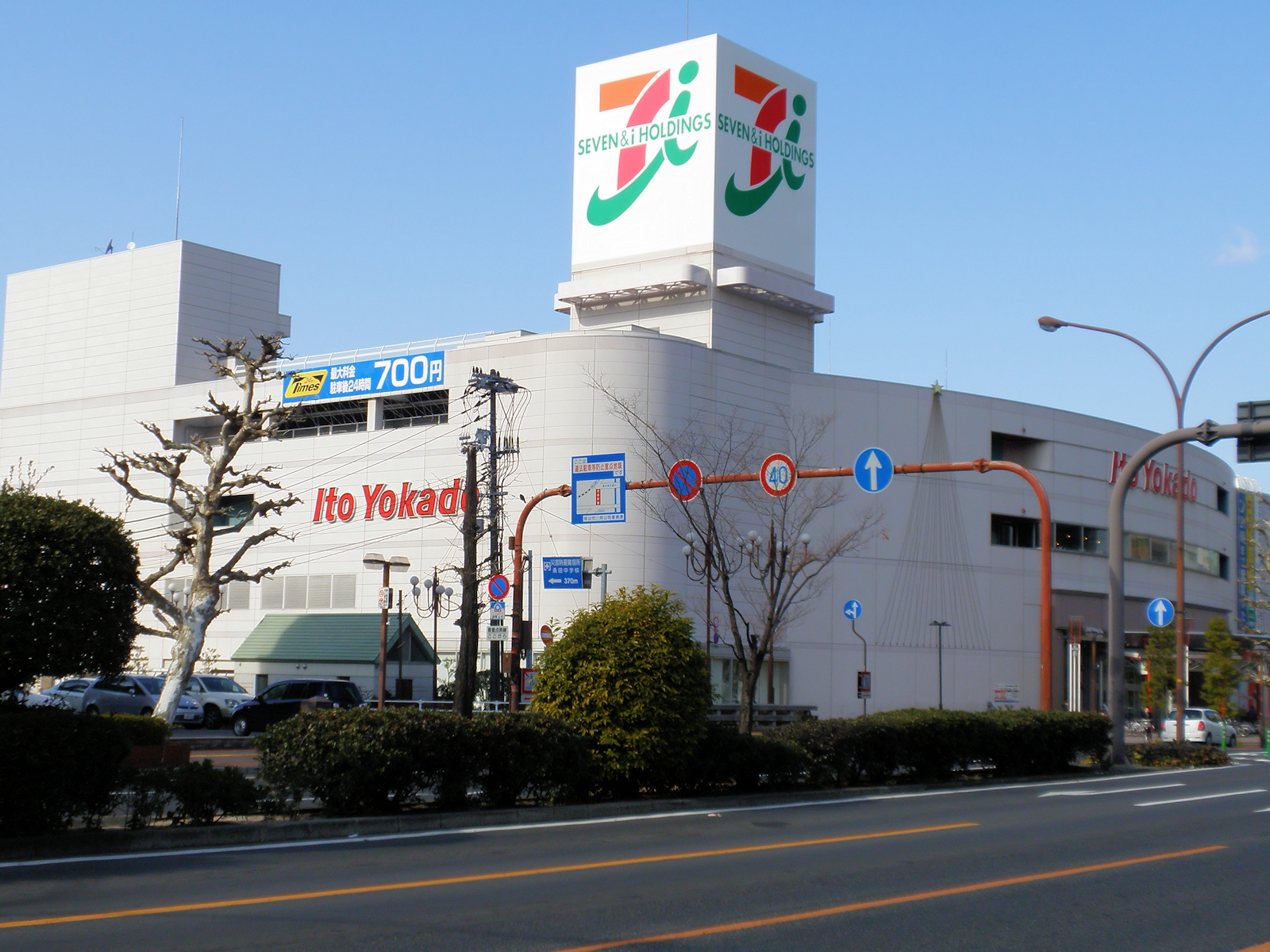|
Higashi-Murayama Station
is a junction passenger railway station located in the city of Higashimurayama, Tokyo, Japan, operated by the private railway operator Seibu Railway. Lines Higashi-Murayama Station is served by the Seibu Shinjuku Line, the Seibu Kokubunji Line, and the Seibuen Line. It is 26.0 km from the Tokyo terminus of the Seibu Shinjuku Line at Seibu Shinjuku Station and 7.8 kilometers from the terminus of the Seibu Kokubunji Line at Kokubunji Station. All trains (including limited express services) stop at this station. It is also the terminus station of the Seibuen Line. Station layout Higashi-Murayama Station has two entrances, east and west, with one set of ticket barriers located centrally above the tracks. The platforms are connected by three overhead passageways. The station has three island platforms serving six tracks. Platforms File:Higashimurayama Station West 2009.jpg, The west side of the station, September 2009 File:Higashimurayama-Sta-Gate.JPG, The ticket barri ... [...More Info...] [...Related Items...] OR: [Wikipedia] [Google] [Baidu] |
Seibu Shinjuku Station
is a railway station in Shinjuku, Tokyo, Japan, operated by the private railway operator Seibu Railway. It is the terminus of the 47.5 km (30 mile) Seibu Shinjuku Line, which extends to in Saitama Prefecture. The station is located approximately 420 meters (460 yards) by foot from Shinjuku Station. It is part of the Shinjuku Prince Hotel and Seibu Shinjuku PePe shopping complex, with the ticket machines and platforms located on the second-floor level. The main entrance is located at the southern end, and a smaller "North entrance" is located at the north end of the station. Platforms The station has three elevated platforms serving three tracks. Platform 1 is normally used for all-stations "Local" services, platform 2 is normally used for "Limited express" and "Rapid express" services, and platform 3 is normally used for "Rapid", "Express", and "Semi express" services. File:Seibu-Shinjuku Station North exit 20110319.jpg, North exit, March 2011 File:Seibu-Shinjuku_Stati ... [...More Info...] [...Related Items...] OR: [Wikipedia] [Google] [Baidu] |
Railway Stations In Japan Opened In 1894
Rail transport (also known as train transport) is a means of transport that transfers passengers and goods on wheeled vehicles running on rails, which are incorporated in tracks. In contrast to road transport, where the vehicles run on a prepared flat surface, rail vehicles (rolling stock) are directionally guided by the tracks on which they run. Tracks usually consist of steel rails, installed on sleepers (ties) set in ballast, on which the rolling stock, usually fitted with metal wheels, moves. Other variations are also possible, such as "slab track", in which the rails are fastened to a concrete foundation resting on a prepared subsurface. Rolling stock in a rail transport system generally encounters lower frictional resistance than rubber-tyred road vehicles, so passenger and freight cars (carriages and wagons) can be coupled into longer trains. The operation is carried out by a railway company, providing transport between train stations or freight customer faciliti ... [...More Info...] [...Related Items...] OR: [Wikipedia] [Google] [Baidu] |
List Of Railway Stations In Japan ...
The links below contain all of the 8579 railway stations in Japan. External links {{Portal bar, Japan, Trains * Railway stations Japan Japan ( ja, 日本, or , and formally , ''Nihonkoku'') is an island country in East Asia. It is situated in the northwest Pacific Ocean, and is bordered on the west by the Sea of Japan, while extending from the Sea of Okhotsk in the north ... [...More Info...] [...Related Items...] OR: [Wikipedia] [Google] [Baidu] |
Tachikawa Station
is a junction passenger railway station located in the city of Tachikawa, Tokyo, Japan, operated by the East Japan Railway Company (JR East). Lines Tachikawa Station is served by the Chūō Main Line, and is located 37.1 kilometers from the starting point of the line at Tokyo Station. It is also a terminus for both the Ōme Line and Nambu Lines. Although the Itsukaichi Line does not reach Tachikawa, a few trains on that line continue along the Ome Line tracks to serve this station. Station layout This station consists of four ground-level island platforms serving eight tracks, with an elevated station building located above the platforms. The station has a "Midori no Madoguchi" staffed ticket office. Tachikawa-Minami Station and Tachikawa-Kita Station on the Tama Toshi Monorail Line flank Tachikawa Station, and are connected to it by decks. The Lumine department store occupies the upper floors of the station building. Platforms Track layout History The Kōbu ... [...More Info...] [...Related Items...] OR: [Wikipedia] [Google] [Baidu] |
Ito-Yokado
is a Japanese general merchandise and department store, originally founded in 1920. In 2005, it was reorganized, as part of a corporate restructuring, as a subsidiary of the Seven & I Holdings Co. As of March 2013, there are 178 Ito-Yokado stores operating in Japan. Since entering the Chinese market in 1997, opening their first store in the Chunxilu shopping district of Chengdu, the company has been operating eight stores in Beijing and six in Chengdu. The company formed a joint venture with Wangfujing Department Store and China Huafu Trade & Development Group Corp. to open one of five stores in Beijing. As of January 2013, there are fourteen Ito-Yokado stores in China. Musical Codes Inside Ito-Yokado, the staff working at the register can play instrumentals of famous musical pieces, which is a code to workers in the store for specific things to do. These are: * ''Help!'' - (The Beatles) - A call for additional staff to man the tills during periods of high customer traffic ... [...More Info...] [...Related Items...] OR: [Wikipedia] [Google] [Baidu] |
Island Platform
An island platform (also center platform, centre platform) is a station layout arrangement where a single platform is positioned between two tracks within a railway station, tram stop or transitway interchange. Island platforms are popular on twin-track routes due to pragmatic and cost reasons. They are also useful within larger stations where local and express services for the same direction of travel can be provided from opposite sides of the same platform thereby simplifying transfers between the two tracks. An alternative arrangement is to position side platforms on either side of the tracks. The historical use of island platforms depends greatly upon the location. In the United Kingdom the use of island platforms is relatively common when the railway line is in a cutting or raised on an embankment, as this makes it easier to provide access to the platform without walking across the tracks. Advantages and tradeoffs Island platforms are necessary for any station with many th ... [...More Info...] [...Related Items...] OR: [Wikipedia] [Google] [Baidu] |
Limited Express
A limited express is a type of express train service. It refers to an express service that stops at a limited number of stops in comparison to other express services on the same or similar routes. Japan The term "limited express" is a common translation of the Japanese compound noun ; literally "special express"; often abbreviated as . Although some operators translate the word differently, this section is about ''tokubetsu kyūkō'' trains in Japan regardless of the translation by the operators. This term also includes terms with ''limited express'' in them, such as . There are two types of limited express trains: intercity and commuter. The former type of limited express trains generally use long-distance coaches, equipped better than other ordinary express trains, including reserved seating, dining cars or food and beverage carts, and "green cars" (first class cars). The latter type of limited express train usually incurs no surcharge, but seating is usually first-come, f ... [...More Info...] [...Related Items...] OR: [Wikipedia] [Google] [Baidu] |
Kokubunji Station
is an interchange railway station located in the city of Kokubunji, Tokyo, Japan, operated by East Japan Railway Company (JR East) and private railway operator Seibu Railway. Lines Kokubunji Station is served by the Chūō Line (Rapid) and is 31.4 kilometers from the terminus of the line at Tokyo. It also forms a terminus for both the Seibu Kokubunji and Seibu Tamako Lines. Station layout The JR East side of the station consists of two island platforms serving four tracks. The station has a "Midori no Madoguchi" staffed ticket office. The Seibu portion of the station has one side of a former island platform (Platform 5) parallel to and north of the JR platforms. Platform 6 is now closed. Platform 7 is further north again but is above and perpendicular to the other platforms. JR East JR Platforms Kokubunji Station platform 5 waiting room 20131116.JPG, The passenger waiting room on platform 5, November 2013 Seibu Railway Seibu Platforms File:Kokubunji Station p ... [...More Info...] [...Related Items...] OR: [Wikipedia] [Google] [Baidu] |
Terminal Station
A train station, railway station, railroad station or depot is a railway facility where trains stop to load or unload passengers, freight or both. It generally consists of at least one platform, one track and a station building providing such ancillary services as ticket sales, waiting rooms and baggage/freight service. If a station is on a single-track line, it often has a passing loop to facilitate traffic movements. Places at which passengers only occasionally board or leave a train, sometimes consisting of a short platform and a waiting shed but sometimes indicated by no more than a sign, are variously referred to as "stops", "flag stops", " halts", or "provisional stopping places". The stations themselves may be at ground level, underground or elevated. Connections may be available to intersecting rail lines or other transport modes such as buses, trams or other rapid transit systems. Terminology In British English, traditional terminology favours ''railway station'' ... [...More Info...] [...Related Items...] OR: [Wikipedia] [Google] [Baidu] |
Seibu Railway
is a conglomerate based in Tokorozawa, Saitama, Japan, with principal business areas in railways, tourism, and real estate. Seibu Railway's operations are concentrated in northwest Tokyo and Saitama Prefecture; the name "Seibu" is an abbreviation of "west Musashi", referring to the historic name for this area. It and its holding company hold shares of numerous bus, hotel and tourism operations nationwide. History "Seibu Railway" was originally the name of a tram service between Shinjuku and Ogikubo, which was transferred to the Tokyo metropolitan government in 1951 and eventually closed in 1962. The Seibu Railway was acquired in 1921 by the Kawagoe Railway, which had operated a train service between Kokubunji and Kawagoe since 1894; the merged company kept the "Seibu" name and expanded its main line to Takadanobaba, forming what is now known as the Seibu Shinjuku Line. The current Seibu Railway is a product of a 1945 merger between the former Seibu Railway and the Musashino ... [...More Info...] [...Related Items...] OR: [Wikipedia] [Google] [Baidu] |
Private Railway
A private railway is a railroad run by a private business entity (usually a corporation but not need be), as opposed to a railroad run by a public sector. Japan In Japan, , commonly simply ''private railway'', refers to a public transit railway owned and operated by private sector, almost always organized as a joint-stock company, or in Japanese: kabushiki gaisha (lit. stock company), but may be any type of private business entity. Although the Japan Railways Group (JR Group) companies are also kabushiki gaishas, they are not classified as private railways because of their unique status as the primary successors of the Japanese National Railways (JNR). Voluntary sector railways (semi-public) are additionally not classified as ''shitetsu'' due to their origins as rural, money-losing JNR lines that have since been transferred to local possession, in spite of their organizational structures being corporatized. Among ''private railways'' in Japan, the categorizes 16 companies as "ma ... [...More Info...] [...Related Items...] OR: [Wikipedia] [Google] [Baidu] |




.jpg)